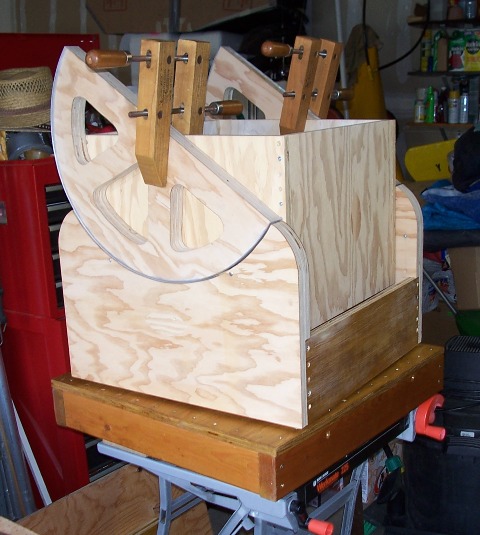Michael Hotka's
My New Telescope Construction
Rocker Base Progress Through September 10, 2006
Making the Azimuth Gear
Motor Mounts and Orientations
Ground Board that Fits - February 11, 2007
Rocker Base Taking Shape - September 27, 2008
Reworked Motor Mounts with Thrust Protection - September 28, 2008
Azimuth Motor Mounted Inside Rocker Box Base - September 29, 2008
Met an old friend at the 2010 Texas Star Party who told
me his tale of adding
a Mel Bartel's controller to his telescope and how he was much happier
with his telescope control system when he upgraded to a ServoCat controller
with Digital Setting Circles.
So when I returned from the star party, I bought new parts
from Randy Cunningham
of Astrosystems in La Salle, CO - June, 2010.
Basically overnight, the scope construction went from this:

to this:
And the completion of my dream scope was finally in sight...
Progress Labor Day Weekend -September, 2010
With all my careful calculations from the Tom Krajci's article, there was something wrong. The spring, that the calculations showed would do the job, showed some signs of counterbalance, but did not counter balance the scope. I was disappointed. (Later analysis showed I calculated the spring K value wrong. I had calculated inches per pound, INSTEAD of pounds per inch).
So, Barbara and I took a trip back to Iowa in early March, 2011 to see all our folks. My dad has always been a huge part of my telescope building efforts. In discussing the equations and the performance of the spring to counter balance my telescope, I found out he is a genius on levers, which is what this counter balance system is all about. He had great suggestions, which I implemented upon returning home, and the finished pictures are below.
One thing my dad suggested is not to let the cable fold back on itself, basically rolling over the top. He indicated you loose a lot of work from the spring when you allow this to happen. At his suggestion, I added screws to catch the cable to keep the cable pulling the spring strongly. With these screws, the cable never rolls over the top and back upon itself. Also, I moved the screws out as close to the edge of the altitude bearing as I could, thus increasing the lever distance and getting more pull from the springs.
I needed two springs on each side to do the job. The lower spring is a .54 gauge wire spring and the upper spring is a .63 gauge wire spring. Together, with an identical set on the other side, the scope is now balanced in all angles of altitude. The combined K Value for each set is 3.32. With the guide pin distance I choose, each set of springs yeilds 476 in-lbs of force, more than enough to balance the 10 lb, 900 in-lb, downward force at the very front of my telescope.
Below are more pictures of the finished spring system on March 31, 2011.
What I have found with my long focal length and 90 inches of truss tubes and upper cage, that the scope is now a bit tipsy when it is pointed more than 45 degrees towards the horizon. Randy Cunningham suggested to make a bigger foot print at the base. So I glued up these pieces of wood, ensuring that they are directly over the existing base feet. This is so that when I attached this stabilizing base to the existing base feet, all the wood lines up nicely. I added a stiffener piece to help strengthen the joint. See the pictures below:
I will test the system in the field, adjusting the stabilizing base feet until I have the tipsiness out of the system. Then I will permanently attach these feet to the stabilizing base and finish the wood.
Back to Main Astronomy Page